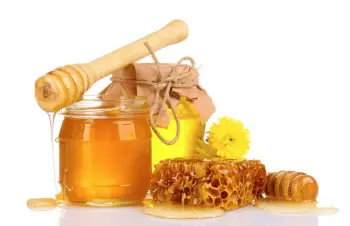By Sayer Ji
Contributing Writer for Wake Up World
Amazingly, something as simple as crude honey has been found to alleviate an embarrassing scalp condition that most body care products and drugs can’t even make a dent in.
Honey’s strange power to resolve chronic dandruff and seborrheic dermatitis, while common knowledge within traditional ‘folk medicine’ systems of healing and countless personal anecdotes, has only recently been ‘clinically confirmed’ to the point where a peer-reviewed study was published on the phenomenon in the European Journal of Medical Journal, over a decade ago.
Titled, “Therapeutic and prophylactic effects of crude honey on chronic seborrheic dermatitis and dandruff,”[i] researchers investigated the use of crude honey applied topically to thirty patients with chronic seborrheic dermatitis of the scalp, face and front of the chest. Seborrheic dermatitis is a common skin disorder that mainly affects the scalp, usually causing itchy, scaly, red skin and stubborn dandruff, and is often resistant to conventional, chemical-based treatment and a significant source of embarrassment.
[pro_ad_display_adzone id=”110028″]
In the study, twenty male patients and 10 females, between the ages of 15 and 60 years, presented with scaling, itching and hair loss with lesions described as “scaling macules, papules and dry white plaques with crust and fissures.” The patients were instructed to apply diluted crude honey (90% honey diluted in warm water) every other day on the lesions with gentle rubbing for 2-3 minutes. After 3 hours, the honey was gently rinsed with warm water. The patients were monitored for changes in itching, scaling, hair loss and lesions during the treatment period, which lasted 4 weeks. The results of the study were remarkable:
“Itching was relieved and scaling disappeared within one week. Skin lesions were healed and disappeared completely within 2 weeks. In addition, patients showed subjective improvement in hair loss.”
Additionally, those patients who saw improvement in the initial phase of treatment were enrolled in a ‘prophylactic phase,’ intended to prevent relapse, lasting six months. The results were reported as followed:
Half patients were treated with the topical honey once weekly and the other half served as control. All the patients responded markedly with application of honey. Itching was relieved and scaling disappeared within one week. Skin lesions were healed and disappeared completely within 2 weeks. In addition, patients showed subjective improvement in hair loss. None of the patients (15 patients) treated with honey application once weekly for six months showed relapse while the 12/15 patients who had no prophylactic treatment with honey experienced a relapse of the lesions 2-4 months after stopping treatment.
The conclusion of the study was that, “crude honey could markedly improve seborrheic dermatitis and associated hair loss and prevent relapse when applied weekly.”
So, how does honey work its magic? One explanation is that chronic seborrheic dermatitis and dandruff are caused by the overgrowth of natural skin pathogens, including fungi known as dermatophytes, and honey is an excellent broad spectrum antibacterial and antifungal. It also has significant wound-healing and anti-inflammatory properties, making it ideal for the treatment of inflammatory and pathogen-associated skin conditions. [Read more: 5 Amazing Healing Honey Facts]
We should not be surprised by these remarkable results. Honey has been considered one of nature’s most remarkable gifts to mankind since ancient Indian (vedic) civilization. [ii] In ancient Egyptian culture honey was the most popular drug mentioned: 500 times in 900 remedies.[iii] We can assume humankind’s appreciation for honey as both a medicine and food stretches back much further, as intimated by 8,000 year old Stone Age paintings.[iv] Presently, the GreenMedInfo.com database contains research on over 50 health benefits associated with honey use. View the research here: Honey Health Benefits.
For additional research on natural interventions for seborrheic dermatitits visit GreenMedInfo’s research page here: Natural Remedies for Seborrheic Dermatitis
Article References:
[i] N S Al-Waili. Therapeutic and prophylactic effects of crude honey on chronic seborrheic dermatitis and dandruff. Eur J Med Res. 2001 Jul 30 ;6(7):306-8. PMID: 11485891
[ii] Telles S, Puthige R, Visweswaraiah NK. An Ayurvedic basis for using honey to treat herpes. Med Sci Monit 2007; 13: LE17-17.
[iii] Al-Jabri AA. Honey, milk and antibiotics. Afr J Biotechnol 2005; 4:1580-1587.
[iv] Bansal V, Medhi B, Pandhi P. Honey -A remedy rediscovered and its therapeutic utility. Kathmandu Univ Med J 2005; 3:305-309.
Recommended articles by Sayer Ji:
- The Powerful Aspirin Alternative Your Doctor Never Told You About
- 13 Evidence-Based Medicinal Properties of Coconut Oil
- Group Drumming Better Than Prozac, Study Suggests
- 25 Cancer Stem-Cell Killing Foods That Are Smarter Than Chemo and Radiation
- Ibuprofen Can Stop Your Heart – 31% Increase in Cardiac Arrest Risk
- How Pomegranate Puts Chemo and Radiation to Shame
- How Turmeric Can Save the Aging Brain From Dementia and Premature Death
- Dramatic Recovery in Parkinson’s Patient with Gluten Free Diet
- 6 Bodily Tissues That Can Be Regenerated Through Nutrition
- Fluoride Literally Turns the Pineal Gland to Stone, Research Suggests
- Why All Diabetics Should Know About Turmeric
About the author:
Sayer Ji is the founder of Greenmedinfo.com, a reviewer at the International Journal of Human Nutrition and Functional Medicine, Co-founder and CEO of Systome Biomed, Vice Chairman of the Board of the National Health Federation, and Steering Committee Member of the Global Non-GMO Foundation.
For more, visit GreenMedInfo.com and Facebook.com/GreenMedInfo, or sign up for GreenMedInfo’s free e-Newsletter.
© January 1st, 2014 GreenMedInfo LLC. This work is reproduced and distributed with the permission of GreenMedInfo LLC. Want to learn more from GreenMedInfo? Sign up for their newsletter here.
[pro_ad_display_adzone id=”110027″]








